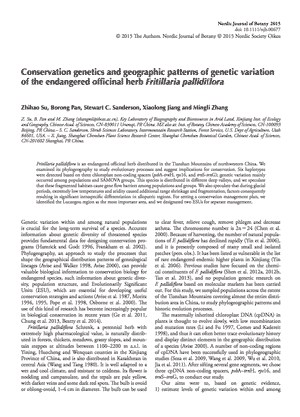NEWS 2015
Conservation genetics and geographic patterns of genetic variation of the endangered officinal herb Fritillaria pallidiflora
Zhihao SU¹, Borong PAN¹, Stewart C. SANDERSON³, Xiaolong JIANG⁴, Mingli ZHANG¹,²
Nordic Journal of Botany
doi:10.1111/njb.00677
¹Key Laboratory of Biogeography and Bioresources in Arid Land, Xinjiang Inst. of Ecology and Geography, Chinese Acad. of Sciences, CN-830011 Urumqi, PR China
²Inst. of Botany, Chinese Academy of Sciences, CN-100093 Beijing, PR China
³Shrub Sciences Laboratory, Intermountain Research Station, Forest Service, U.S. Dept of Agriculture, Utah 84601, USA
⁴Shanghai Chenshan Plant Science Research Center, Shanghai Chenshan Botanical Garden, Chinese Acad. of Sciences, CN-201602 Shanghai, PR China.
Abstract
Fritillaria pallidiflora is an endangered officinal herb distributed in the Tianshan Mountains of northwestern China. We examined its phylogeography to study evolutionary processes and suggest implications for conservation. Six haplotypes were detected based on three chloroplast non-coding spacers (psbA-trnH, rps16, and trnS-trnG); genetic variation mainly occurred among populations and SAMOVA groups. This species is distributed in different deep valleys, and we speculate that these fragmented habitats cause gene flow barriers among populations and groups. We also speculate that during glacial periods, extremely low temperatures and aridity caused additional range shrinkage and fragmentation, factors consequently resulting in significant intraspecific differentiation in allopatric regions. For setting a conservation management plan, we identified the Lucaogou region as the most important area, and we designated two ESUs for separate management.

